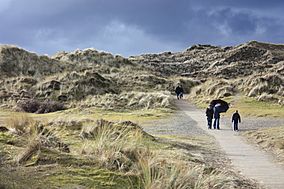Murlough Nature Reserve facts for kids
Quick facts for kids Murlough Nature Reserve |
|
|---|---|

Murlough Nature Reserve, February 2010
|
|
| Location | County Down, Northern Ireland |
| Nearest city | Belfast |
| Area | 697 acres (2.82 km2) |
| Established | 1967 |
| Governing body | National Trust |
Murlough Nature Reserve is a special place on the coast of County Down in Northern Ireland. It's near the town of Newcastle. From here, you can see Slieve Donard, which is the tallest mountain in the Mourne Mountains, and also Dundrum Bay. This reserve has amazing sand dunes that are 6,000 years old! The National Trust has looked after them since 1967. It was the first nature reserve in Ireland.
Contents
What Makes Murlough Special?
Murlough is huge, covering about 697 acres (282 hectares). It has the biggest area of 'dune heath' (a special type of grassy land) in all of Ireland. There are lots of paths and boardwalks to explore the dunes safely.
Animals and Plants
Many birds make their homes here, like meadow pipits, skylarks, cuckoos, stonechats, linnets, and reed buntings. You might also spot grey seals and common seals resting on the shore. Between 50 and 130 seals often use this area to rest and find food. Rare plants like the pyramidal orchid and carline thistle also grow here.
Murlough also has a shingle beach and a four-mile-long sandy beach called a Blue Flag strand. This means the beach is very clean and safe.
Protecting the Land
Murlough has about one-fifth of all the dune heathland in the British Isles. But this special habitat is always at risk from plants like bracken and gorse growing too much. Other plants that don't belong here, like Sea Buckthorn, can also cause problems. To protect the land, the National Trust started a five-year project in 1999. Murlough is so important that it has been named an Area of Special Scientific Interest and a Special Area of Conservation.
A Look Back in Time
People have lived in the Murlough area for a very long time. We have found signs of people from the Stone Age (Neolithic times) and the Bronze Age, right up to today.
Rabbit Warrens and Sand Dunes
In the 1100s, the Normans created a rabbit farm, called a warren, here. They raised rabbits for their meat and fur. This rabbit farm actually helped shape the heath and grasslands we see today. Later, in the 1200s and 1300s, there were some very big storms. These storms moved a lot of sand, which created the unusually tall sand dunes you can explore now.
World War II History
During the Second World War, the US Army used the sand dunes at Murlough for training.
Butterflies and Moths
Murlough Nature Reserve is a fantastic place for butterflies and moths! More than 750 types of moths have been found here, which is more than anywhere else in Northern Ireland.
Butterfly Species
Out of 23 types of butterflies found at Murlough, one of the most important is the marsh fritillary (Euphydryas aurinia). Other interesting butterflies include the dark-green fritillary (Argynnis aglaja), grayling (Hipparchia semele), and cryptic wood white (Leptidea juvernica). Sadly, one butterfly, the wall brown (Lasiommata megera), hasn't been seen here for several years and is thought to be gone from the site.
Moth Species
Some of the moths you might find here are the small elephant hawkmoth (Deilephila porcellus), sand dart (Agrotis ripae), and tiny micro moths like Pyrausta cingulata and Hysterophora maculosana. In total, 775 different types of butterflies and moths have been recorded at Murlough.
Rare Visitors
Sometimes, rare moths that have traveled from far away are spotted here. These include the cosmopolitan (Leucania loreyi), tawny pinion (Lithophane semibrunnea), and double line (Mythimna turca). In 2012, a Stephens' gem moth (Megalographa biloba) was seen at Murlough. This was the first time this moth, which usually lives in North America, had ever been recorded in Ireland!
Images for kids






